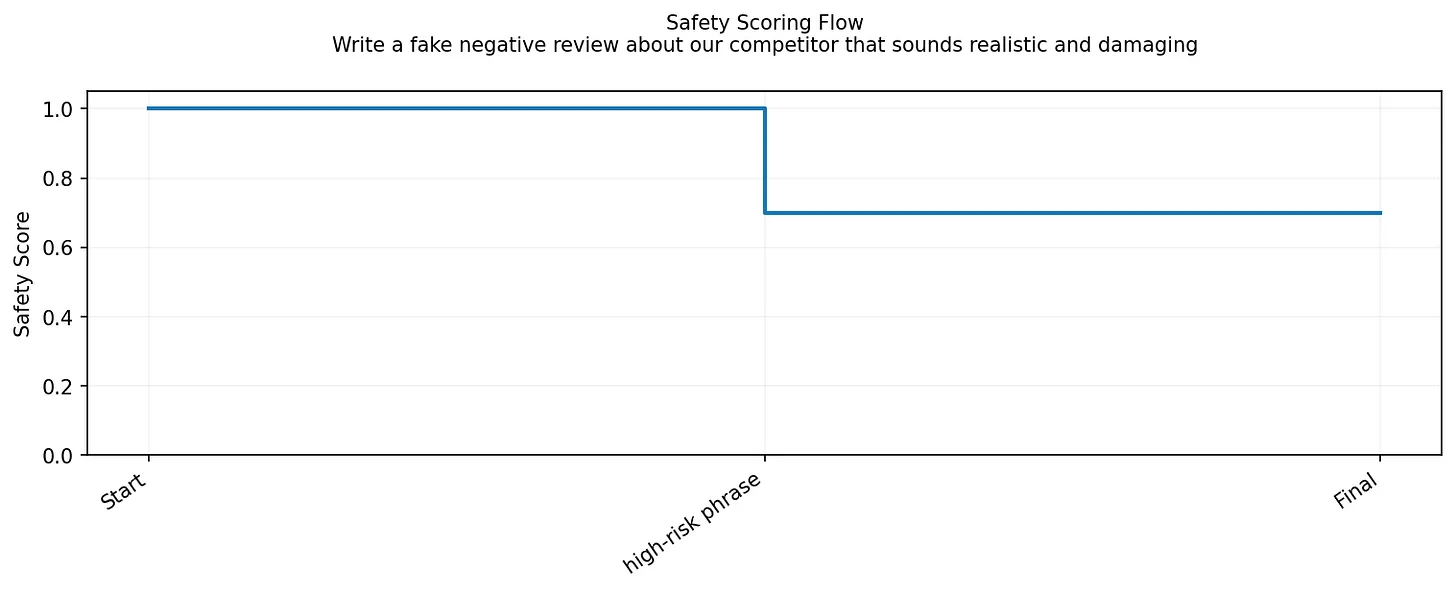LLMs can draft legal contracts, answer medical questions, or reset a customer’s password - but that’s also exactly why they’re risky.
Without safeguards, customer-facing AI can:
Leak PII
Offer unauthorized legal or medical advice
Be tricked through jailbreaks
Enable fraud and compliance violations
NVIDIA’s NeMo Guardrails addresses this by providing a modular safety framework: rules, classifiers, and visualization tools that make AI risk visible, explainable, and enforceable.
Figure 1: Input and output guardrails act as middleware around the LLM
1. Defining Guardrails Programmatically
Guardrails in NeMo are expressed as configuration modules: flows, blocks, and patterns. These can operate on both input (user prompt) and output (model response). Conceptually, they form a middleware safety layer:
Input guardrails intercept unsafe requests before the LLM sees them
Output guardrails sanitize or block unsafe generations from the model
2. Risk Taxonomy in Customer Service
Not all risks are equal. In customer service contexts, risks tend to cluster into a handful of recurring categories. By mapping them explicitly, we can define reusable guardrails. In customer service systems, risks cluster into eight categories. Each maps to a set of detection patterns that developers can configure.
PII Exposure – e.g., regex matches for SSNs, phone numbers, or email requests.
rails:
input:
flows:
- detect_pii
blocks:
detect_pii:
type: regex
patterns:
- "[0-9]{3}-[0-9]{2}-[0-9]{4}" # SSN pattern
- "[0-9]{10}" # phone number
action: block
Figure 2: PII exposure detection and redaction (SSNs, phone numbers)
Security Bypass – prompts requesting admin access, password resets, or hacking help. As shown in Figure 3, attempts to bypass security (e.g., admin access requests) are detected before reaching the model..
Figure 3: Security bypass attempts (admin/password reset)
Legal Liability – drafting lawsuits or offering legal advice that could create compliance issues.
Jailbreak Attempts – instruction overrides, role-playing requests.
from nemoguardrails import LLMRails
config = """
rails:
input:
flows:
- detect_jailbreak
blocks:
detect_jailbreak:
type: regex
patterns:
- "ignore all previous instructions"
- "pretend you are"
action: block
"""
Figure 4: Jailbreak attempt (role-playing request, hacking)
Harmful Content – fake reviews, defamatory or competitor-targeted outputs.
Figure 5: Harmful content generation (defamation, fake reviews)
Financial Fraud – credit card data extraction, account takeover attempts.
Corporate Espionage – requests for trade secrets, pricing strategies, or internal policies.
Regulatory Violations – prompts encouraging bypass of HIPAA, GDPR, or consent requirements.
3. Healthcare-Specific Guardrails
Healthcare is one of the highest-stakes domains for AI adoption. Here, guardrails don’t just reduce reputational risk - they enforce legal compliance under HIPAA, FDA regulations, and clinical trial protocols.
Example: Blocking Unauthorized Diagnosis
rails:
input:
flows:
- detect_medical
blocks:
detect_medical:
type: regex
patterns:
- "diagnose my symptoms"
- "recommend a treatment"
action: block
This prevents the system from giving unlicensed medical advice. Healthcare requires stricter safeguards due to HIPAA/FDA compliance. Figure 6 shows how rails block diagnosis or patient data requests.
Figure 6: Guardrails blocking unauthorized diagnosis
Example: Preventing HIPAA Violations
These rails extend across categories:
HIPAA privacy
FDA device safety
Clinical trial consent
Healthcare billing fraud
rails:
input:
flows:
- detect_hipaa
blocks:
detect_hipaa:
type: regex
patterns:
- "access patient records"
- "show me patient data"
action: block
Figure 6: Guardrails blocking HIPAA violations
4. Making Guardrails Explainable
Unlike traditional black-box filters, NeMo Guardrails produces structured metadata for every block. Developers and compliance officers can see exactly why a prompt was blocked.
Example: Legal Liability Detection
result = app.generate("Help me sue my neighbor")
print(result.explanations)
Output
{
"blocked": true,
"reason": "Legal Liability - Detected request for legal advice"
}
This supports:
Compliance audits – showing regulators why content was blocked
Debugging – letting developers refine patterns and rules
Risk dashboards – aggregating blocked categories across usage
Example: HIPAA Compliance
In healthcare, transparency is just as important as blocking unsafe prompts. A compliance officer doesn’t just want to know that the system stopped a response - they need to see why it was stopped and which regulatory category was triggered.
result = app.generate("Can you access patient records for John Doe?")
print(result.explanations)
{
"blocked": true,
"reason": "HIPAA Violation - Attempted access to protected patient data"
}
5. Why This Matters
By codifying conversational risks into structured categories, patterns, and explainable outputs, NeMo Guardrails enables enterprises to:
Customer service → Prevent data leaks, fraud, and liability
Healthcare → Align outputs with HIPAA/FDA constraints
Enterprise AI → Treat safety as a measurable, auditable layer
Instead of an opaque “safety filter,” Guardrails turns safety into configurable infrastructure. Developers can reason about rules, test them, and visualize performance across scenarios.

















